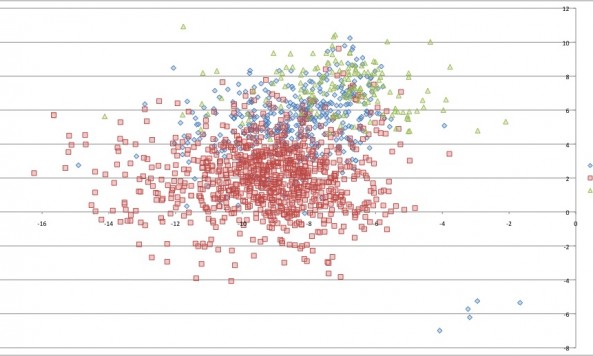When I was putting together my Jeff Karstens post last week, one thing that I noticed that I didn’t mention much in the post is that a much larger number of his fastballs are being classified as two-seamers in 2011 than they were in 2010. I didn’t mention it because I noticed that the same trend for James McDonald earlier this year, even though it didn’t appear that his fastballs were any different in 2011 than they were in 2010. Because Karstens’ groundball numbers have stayed relatively constant this year and because I found other stuff that I thought was more interesting, I left the two-seamers on the curb.
Azibuck and I got to talking about Karstens’ and his two-seamer/sinker a bit in the comments, though, and I thought it’d be interesting and worthwhile to talk about fastballs and two-seamers and sinkers a bit. Two-seamers and sinkers, particularly, are pretty similar pitches that are often hard to tell apart and I thought it’d be interesting to illustrate some differences using the Pirates’ pitching staff
Going back to the beginning, the real difference between a two-seam fastball and four-seam fastball is aerodynamics; because of its seams a baseball can’t be perfectly round and the different ways the seams can be oriented creates different movement on the ball. A four-seam fastball (for anyone that’s unsure, four-seamers are gripped like this) is used because it keeps the seams rotating in a way that allows for maximum velocity and it puts backspin on the ball, which is what keeps it straight. A two-seamer (two-seamers can be gripped either perpindicular or parallel to the seams at their narrowest point). This creates some sidespin that lets two-seamers from right-handed pitchers break down and in on right-handed batters (or vice versa for lefties), though it also takes some velocity off of the ball.
How the two-seamer is used is dependent on the pitcher. McDonald hardly throws one at all and I suspect that he either does it to keep specific hitters off balance from his four-seamer or that he doesn’t throw it at all and he just occasionally gets extra movement from his four-seamer. Some, like Karstens I think, throw lots of two-seamers because their four-seamer just isn’t very fast or very good. And some, like Morton, throw sinkers.
So what’s a sinker? It’s basically an exaggerated two-seamer with more sidespin. Some pitchers accomplish this by putting more pressure on their middle finger. Some generate more spin with arm action. I’m pretty sure this is how Morton does it; if you’ve seen him explain his new windup and arm angle, he usually points out that the three-quarters angle lets him get his hand under the ball a little bit more and that creates the spin for his sinker. Below is a plot I put together with all of the pitches classified as two-seamers or sinkers thrown by Karstens, Morton, and McDonald this year and it’s pretty easy to see the difference.  It’s actually pretty easy to see that each guy has a slightly different two-seamer. Morton’s obviously has the most sink, Karstens is second, and McDonald’s has the least. Compare that to their four-seamers:
It’s actually pretty easy to see that each guy has a slightly different two-seamer. Morton’s obviously has the most sink, Karstens is second, and McDonald’s has the least. Compare that to their four-seamers:  There are actually a bunch of Karstens’ four-seamers hidden behind McDonald’s (McDonald throws the most, by a wide margin) and so their four-seamers overlap quite a bit. You can see that Morton’s three-quarters arm action affects his four-seamer, too, though maybe not quite as dramatically as his two-seamer.
There are actually a bunch of Karstens’ four-seamers hidden behind McDonald’s (McDonald throws the most, by a wide margin) and so their four-seamers overlap quite a bit. You can see that Morton’s three-quarters arm action affects his four-seamer, too, though maybe not quite as dramatically as his two-seamer.
The line between the two-seamer and the sinker is awfully blurry, but you can see that there is definitely some difference from pitcher to pitcher and that a guy who leans on the pitch more, like Morton, does something quite differently with it than someone like Karstens.




















